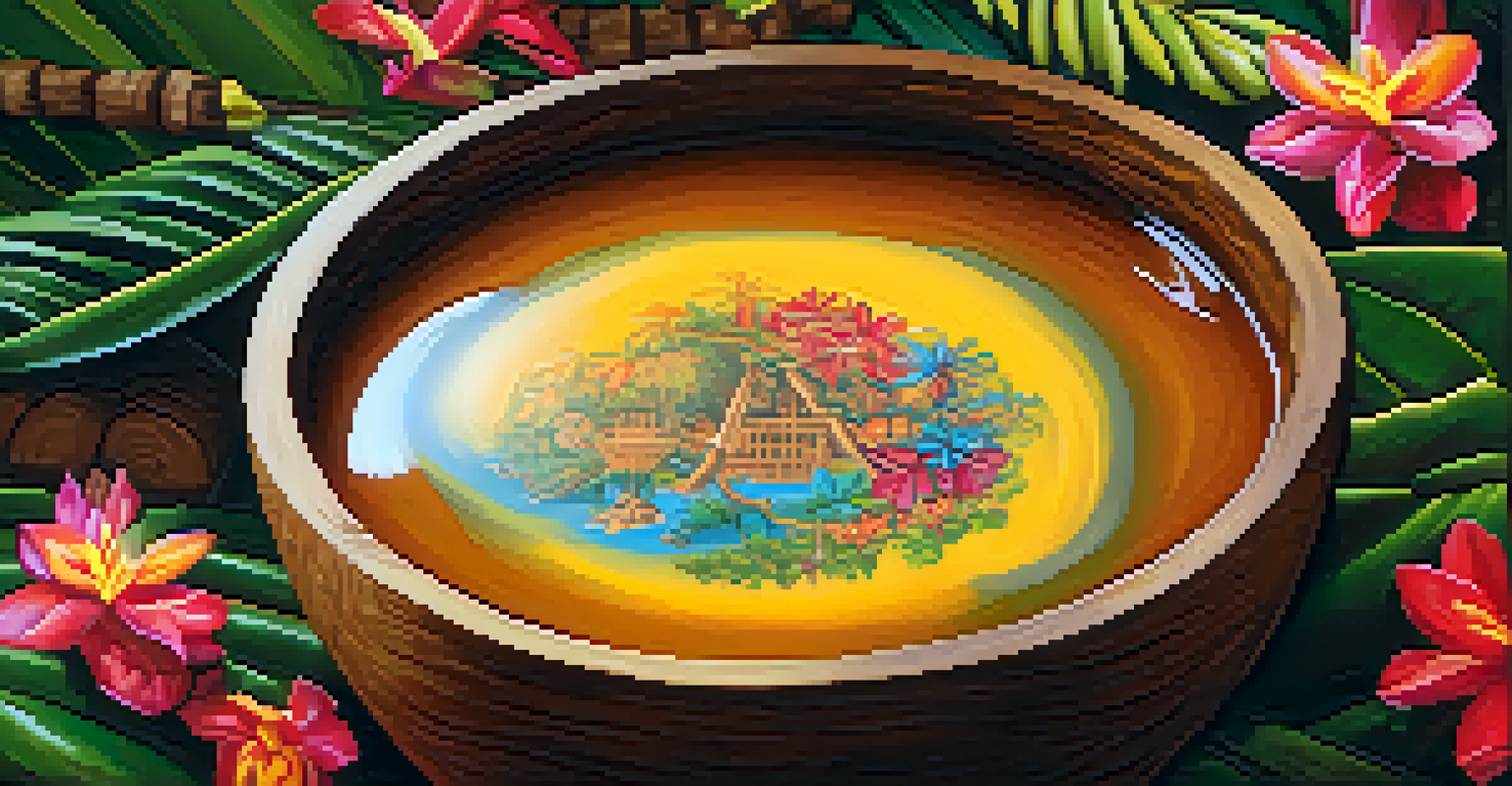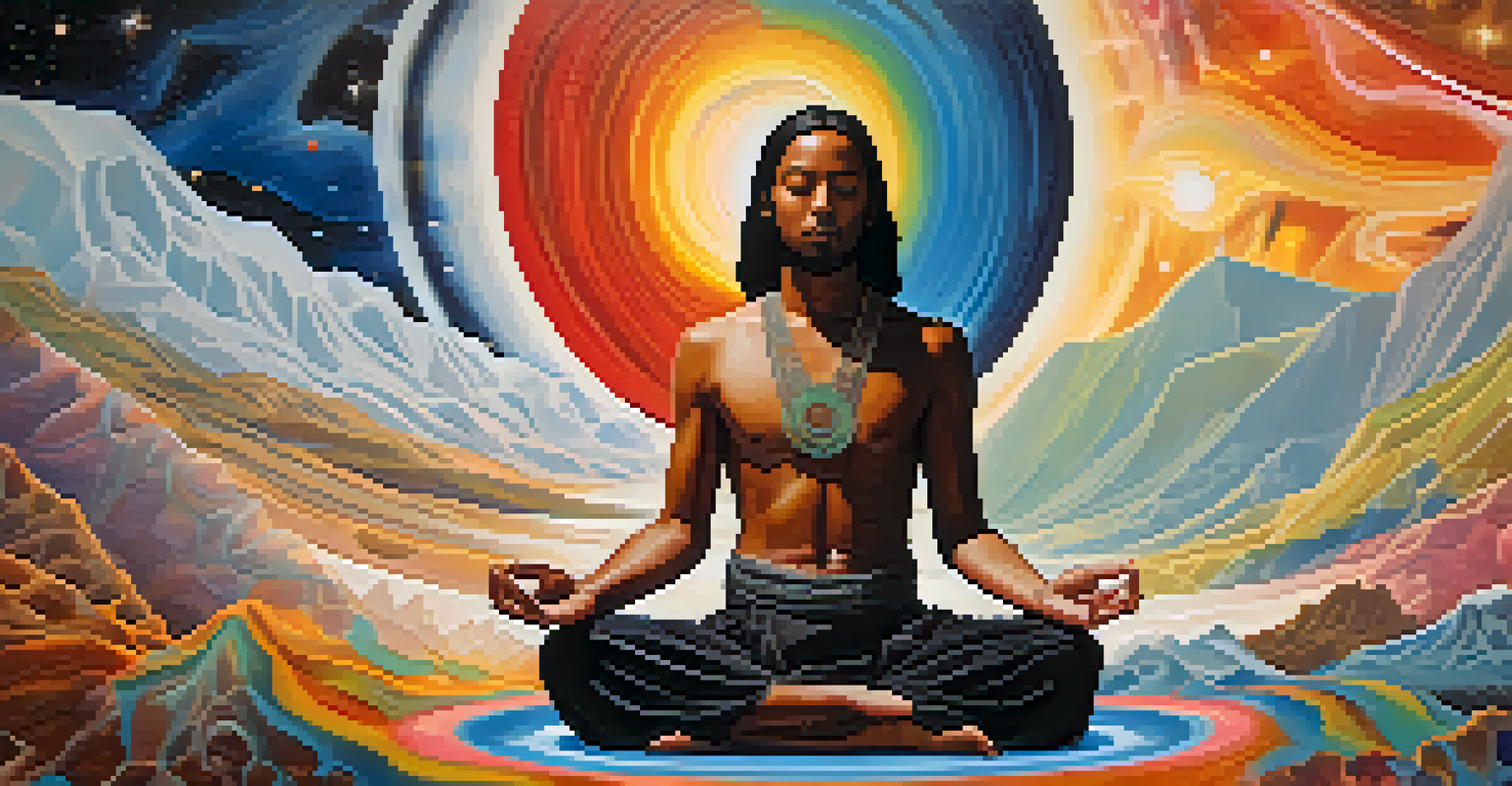Ayahuasca and Time: A Journey Beyond Linear Understanding

Understanding Ayahuasca and Its Cultural Significance
Ayahuasca, a traditional Amazonian brew, is made from two plants: the Banisteriopsis caapi vine and the Psychotria viridis leaf. This powerful concoction has been used for centuries by indigenous tribes for spiritual and healing purposes. It's more than just a drink; it's a gateway to altered states of consciousness where participants often report profound experiences.
The mind is everything. What you think you become.
The brew is known for its psychoactive properties, primarily due to the presence of DMT, which can lead to intense, dream-like visions. These experiences are often described as journeys into the self, where the concept of time becomes fluid and malleable. In many cultures, this journey is viewed as a rite of passage, deepening one's understanding of life and existence.
In modern times, Ayahuasca has gained popularity beyond its traditional roots, attracting seekers from around the globe. People hope to explore their psyche, heal emotional wounds, and connect with the divine. This widespread interest underscores the brew's significance in understanding not just personal history, but also the intricate fabric of time.
The Concept of Time in Indigenous Wisdom
In many indigenous cultures, time is not seen as a linear progression from past to future, but rather as a cyclical or even simultaneous experience. This perspective contrasts sharply with the Western understanding of time, which often prioritizes schedules and deadlines. Instead, indigenous wisdom teaches that past, present, and future are interconnected, offering a rich tapestry of experiences to navigate.

For those who partake in Ayahuasca ceremonies, this non-linear view of time can become a lived experience. Participants often report revisiting past traumas or future possibilities, feeling as though they are simultaneously experiencing multiple timelines. This expanded perception can lead to profound insights, allowing individuals to reframe their understanding of life events.
Ayahuasca's Cultural Roots
Ayahuasca is a traditional Amazonian brew used for centuries by indigenous tribes for spiritual and healing purposes.
This cyclical approach can be likened to a river that flows in multiple directions at once, with various tributaries representing different experiences. By engaging with this concept during an Ayahuasca journey, individuals may find healing and clarity in their lives, enabling them to break free from the constraints of a strictly linear existence.
Experiencing Non-Linear Time During Ayahuasca Journeys
Many participants describe their Ayahuasca experiences as transcending the boundaries of time. They may find themselves reflecting on memories from childhood or glimpsing future possibilities, all within the same session. This blurring of temporal lines can create a sense of timelessness, allowing for deep exploration of one's identity and purpose.
Time is a created thing. To say 'I don't have time,' is like saying, 'I don't want to.'
This phenomenon is often accompanied by vivid visualizations and emotional releases. Individuals may confront unresolved issues or gain insights into their relationships, all while feeling as if time is both stretching and contracting. The experience can be both exhilarating and overwhelming, emphasizing the complexity of human emotion and experience.
Moreover, the concept of time during these sessions can be likened to watching a movie that plays scenes out of order. It invites participants to piece together their narrative, offering a unique opportunity to understand how past experiences shape current behavior and future decisions. This transformative process can lead to significant personal growth.
Ayahuasca and the Healing of Temporal Trauma
One of the most profound aspects of Ayahuasca is its potential to heal temporal trauma. Many individuals carry emotional burdens from past experiences that can hinder their present and future. Through the lens of Ayahuasca, these traumas can be revisited and reframed, allowing for healing and closure.
Participants often find that confronting these past events during their journey provides a sense of liberation. By understanding their experiences in a non-linear context, they can process emotions that may have been buried for years. This healing can lead to a renewed sense of self and a more optimistic outlook on life.
Healing Through Non-Linear Time
Participants often experience time as non-linear during Ayahuasca journeys, allowing them to revisit past traumas and future possibilities.
The process can be likened to peeling back layers of an onion, where each layer represents a different aspect of a person's trauma. As these layers are peeled away, individuals can recognize patterns and beliefs that have held them back, paving the way for healing and growth. The insights gained can empower them to move forward with a deeper understanding of their life journey.
The Role of Guides in Ayahuasca Ceremonies
Guides, often referred to as shamans, play a crucial role in Ayahuasca ceremonies. They help prepare participants for the emotional and psychological journey they are about to undertake. These experienced individuals provide a safe space, ensuring that each person's experience is respectful and meaningful.
The guidance they offer often extends beyond the ceremony itself. They help participants integrate their experiences into their daily lives, emphasizing the importance of understanding the messages received during the journey. This integration is essential to fully grasp the lessons learned and apply them moving forward.
Working with a knowledgeable guide can be compared to having a skilled navigator on a boat navigating through turbulent waters. They provide support and direction, helping participants stay grounded while they explore the depths of their consciousness. This guidance can significantly enhance the overall experience, fostering a sense of safety and trust.
Integration: Bridging the Gap Between Experiences and Reality
Integration is a vital step after an Ayahuasca journey, as it helps individuals process and understand their experiences. Many participants find themselves filled with insights, emotions, and revelations that can feel overwhelming. Without proper integration, these powerful experiences may fade or remain unprocessed, leading to confusion and disorientation.
This phase often involves discussing the journey with others who have experienced Ayahuasca, journaling, or working with mental health professionals. By sharing and reflecting on their experiences, individuals can begin to weave the lessons learned into the fabric of their daily lives. This helps to solidify the healing and insights gained during the ceremony.
Importance of Integration
Integration is crucial after Ayahuasca experiences, as it helps individuals process insights and apply lessons learned to their everyday lives.
Think of this process as translating a foreign language back into your own. The rich and complex experiences of the Ayahuasca journey can be difficult to articulate, but through integration, individuals can find the words and meanings that resonate with their reality. This bridge between experiences and everyday life is essential for ongoing personal development.
The Future of Ayahuasca in a Global Context
As interest in Ayahuasca continues to grow globally, it raises important questions about its cultural appropriation and sustainability. The demand for Ayahuasca ceremonies has surged, leading to the establishment of various retreats and centers worldwide. While this expansion can promote awareness and healing, it also risks commodifying a sacred tradition.
It's crucial for participants and facilitators to approach Ayahuasca with respect for its indigenous origins. This means understanding and honoring the cultural context from which it comes, as well as ensuring that indigenous communities benefit from the increasing interest in their traditions. Sustainable practices are essential to preserve the ecosystem from which Ayahuasca is derived.

The future of Ayahuasca should ideally involve a balance between honoring its roots and embracing the insights it offers to a broader audience. As more people seek to explore their consciousness and heal through this powerful brew, maintaining an ethical approach will be vital in ensuring its longevity and integrity. This journey is not just about personal transformation, but also about fostering a collective respect for the traditions that make it possible.